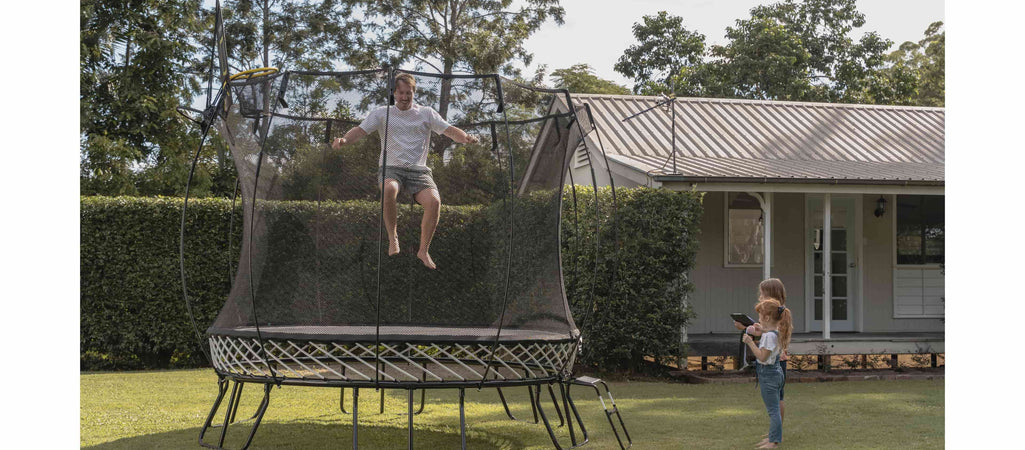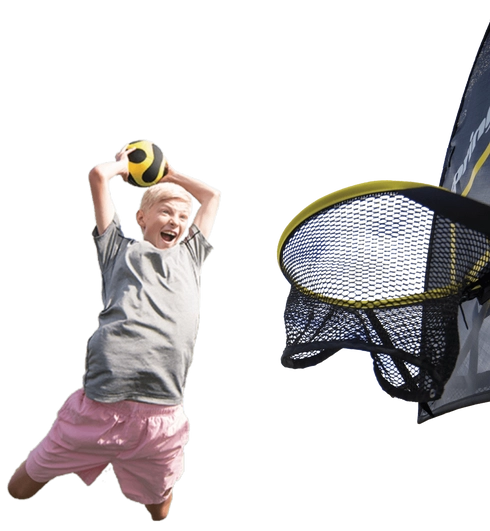Are Trampolines Bad for Your Knees? | Expert Insight
Discover the truth: Are trampolines bad for your knees? Uncover expert insights and get an exclusive trampoline workout!
min read

Have you been wondering, “Are trampolines bad for your knees?”
We’ve got the direct answer for you today. As trampoline experts for over two decades, we have the insight to help you make an informed decision on your physical fitness.
Make sure to read until the end because we’re giving you an example trampoline workout crafted by our experts!
Are Trampolines Bad for Knees?
Trampolines are typically easier on your joints than other forms of exercise, like running on a treadmill, cycling or weightlifting.
Thus, jumping on a trampoline is usually better for your knees.
However, this depends on the type of trampoline you have. Many people gloss over this when buying a trampoline.
We will have more on that point later. But first, let’s get a little “sciencey.”
How Trampolines Impact Your Knees
When you jump up and down on a trampoline, its elastic surface absorbs much of the impact.
This is especially the case for high-quality trampolines. For example, Springfree Trampolines are 30 times more shock absorbent than safety pads on a traditional trampoline.
The trampoline mat absorbs the impact through a combination of material elasticity and tension from the springs or rods (on springless trampolines).
This helps your knees because the elasticity allows them to stretch, which slows down the descent and reduces the force exerted on your joints. This “controlled deceleration” is gentler on your joints than jumping on the ground.
In basic terms, this means that bouncing on a trampoline has less of an impact on your knees.
A study published by the National Library of Medicine verifies this, at least biomechanically. It showed that jumping on a trampoline can reduce knee motion and induce upright lower extremity alignment.
But not all bounces are created equal.
Why Is the Type of Trampoline Important?
Despite being a forgiving surface, knee injuries can occur on trampolines.
Lower extremity injuries are the most common area where trampoline injuries occur. This may show itself as a hyperextension, fracture or other.
How can you avoid a knee injury on a trampoline? Pay attention to the type of trampoline before buying.
When it comes to trampolines for adults and kids, there are two common types:
- Rebounders, or mini trampolines, are predominately used for exercising.

Photo courtesy of Verywell Fit.
- Backyard trampolines, used for both recreational and fitness.

Springfree Trampoline.
Check out Rebounder vs. Trampoline to learn more!
The type and brand of trampoline you buy is crucial. High-end rebounders oftentimes have higher-quality mats, meaning they can absorb your impact better.
On backyard trampolines, springless trampolines can absorb your impact better than trampolines that use metal springs.
If you’re worried about how trampoline jumping will affect your knees, investing in a quality trampoline would be recommended.
Factors Influencing Knee Injuries on Trampolines
There are many factors at play when it comes to trampoline knee injuries. The following considerations can affect your chance of a knee injury:
- Jumping on a low-quality or damaged trampoline.
- Improper jumping technique or jumping too high, which can increase the impact force.
- Trying advanced tricks with no training.
- Multiple people jumping on the trampoline at the same time. This is where the “trampoline fracture” occurs.
- Pre-existing knee conditions, like arthritis.
- Lack of supervision for young children.
- Placing a trampoline on hard or uneven surfaces can affect its shock absorption properties.
Interestingly, the Orthopedic Journal of Sports Medicine found that the risk of suffering a knee-related trampoline injury increased with age.
They discovered that older children, adolescents and adults were at greater risk for knee injuries requiring surgery.
This means that the older you get, the more you must pay attention to the factors above (and the tips in the next section)!

9 Knee-Friendly Trampoline Tips
What you can conclude so far is trampolines are gentler on your knees than other forms of exercise, such as running or playing sports.
However, it is still possible to sustain a trampoline-related knee injury.
But don’t fret: We’re going to give you expert tips to ensure that your knees are protected as best as possible when jumping.
Tip #1: Choose a high-quality trampoline or rebounder.
Tip #2: Only allow one child to jump on the trampoline at a time.
Tip #3: Take note of the trampoline’s weight limit before buying and make sure it can accommodate all jumpers’ weight.
Tip #4: If interested in gymnastics or advanced jumping, take classes to learn how to properly land.
Tip #5: If you have a pre-existing knee condition, consult your doctor before starting a trampoline workout program.
Tip #6: If purchasing a backyard trampoline, make sure it’s installed on a level ground.
Tip #7: Always warm up with stretching or light exercises.
Tip #8: Do periodic inspections of your trampoline for signs of wear or damage.
Tip #9: Listen to your body. If your knees are in pain, give yourself a rest week.
FAQ: Are Trampolines Bad for Your Knees?
We’ve covered a lot of information, and some of it has been quite technical.
If you’re just scanning through, here are quick answers to what we’ve covered in this article:
1. Is Jumping on a Trampoline Better for Your Knees?
Jumping on a trampoline can be considered better for your knees compared to hard surfaces because the trampoline mat absorbs impact, reducing stress on the joints.
However, knee injuries can still occur – so make sure to follow best jumping practices!
2. Are Mini-Trampolines Good for Bad Knees?
Mini trampolines (rebounders) can be beneficial for individuals with bad knees when used appropriately. The controlled, low-impact bouncing may help strengthen muscles around the knee joint without subjecting it to excessive stress.
3. Is Jumping on a Trampoline Bad for Arthritis?
Trampoline jumping, when done with proper technique and within individual physical limits, may not necessarily be bad for arthritis.
However, individuals with arthritis should consult a healthcare professional before engaging in such activities.
4. How Do You Jump On a Trampoline Without Hurting Your Knees?
To jump on a trampoline without hurting your knees, focus on proper landing technique, keeping your knees slightly bent, and avoiding excessive force. Start with gentle bounces and gradually increase intensity as your body adjusts.
5. Can Jumping on a Trampoline Cause Joint Problems?
Improper trampoline use, such as landing with locked knees or overexertion, could potentially lead to joint problems.
Following trampoline safety guidelines, proper warm-up, and controlled jumping can minimise the risk of joint issues.
3 Free Beginner Trampoline Exercises
The answer to “Are trampolines bad for your knees?” will come down to your own risk-reward assessment.
Before saying for sure whether trampoline exercise is best for your fitness goals, you might be curious to see what exercising on a trampoline actually looks like.
The following our three of our favorite jumping exercises you can perform on a backyard trampoline:
Star Jump
1. Starting point: stand straight with your feet on the trampoline and your arms at your sides.
2. Mid move: jump in the air, getting enough height to create a star position at the top of your bounce.
3. Landing: land standing with your legs straight (like the starting point).

Swivel Hips
1. Starting point: stand straight with your feet on the trampoline and your arms at your sides.
2. Mid move: jump up in the air, moving your legs forward into a seated position.
3. Extra move: bounce on your bottom with your legs straight out in front and your palms down with fingers pointed toward your toes.
4. Landing: after the bounce, perform a half twist and land facing the opposite direction.

Tuck Jump
1. Starting point: stand straight with your arms at your sides.
2. Mid move: jump up and while you're in the air, pull your knees to your chest, grasping your hands around your knees or ankles.
3. Landing: land with your body straight and your arms straight above your head.

If you would like to see more exercises, check out our 10 quick and easy trampoline exercises!

